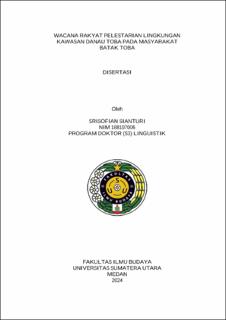| dc.description.abstract | The objective of the research is to categorize the forms of folk discourse, to formulate
ecological wisdom of folk discourse, and to make a revitalization model of folk discourse
on environmental conservation of Lake Toba area. It is also aimed at analyzing folk
discourse on environmental conservation of Lake Toba area by using Eco-linguistic
approach. The research uses ethnographic method. The data are gathered from interview
recording and observation, supported by the data which come from texts of folklore,
proverbs, and 'pantun' (a kind of quatrain) of Batak Toba. The types of folk discourse of
Batak Toba community in Lake Toba area are as follows: 1) expressions which consist of
five types: a) expressions of prohibition to do something concerning the conservation of
forest, rivers, villages, fauna, and flora by using prohibition or negation markers, b)
procedural expressions in conserving fauna and villages by using conjunction 'dung' and
'tingki ', c) conditional expressions in conserving flora an water sources by using
conjunction 'molo ', d) exclamation expressions in conserving fauna and villages by using
exclamation markers 'e ', 'o ', and 'wei ', and e) requesting expression in conserving water
sources by using requesting markers, 'asi roham ', 'santabi ', 'namboru ', and 'ompung';
2) metaphors such as conceptual metaphors by using special concepts which are referred
to daily activities and concepts which reflect the lake as a human being that has spirit ad
ecosystem metaphors, using the form of being dependent on water; 3) proverbs which
consist of three sub-types, namely: a) 'umpama parsorion ' in conserving water sources
by using conjunction 'molo ', b) umpama Sisandok which consists o_f' singular sentence,
and c) 'tudosan' by using comparative word, 'songon '; 4) 'pantun' which consists of two
sub-types: a) 'umpasa' which has four lines, the first two lines are prefatory statement
and the other two lines are its content, and b) 'anian' which consists of two lines and
word repetition in the initial clause; 5) folklore which consists of two three sub-types: a)
myth which uses time markers, 'hian ', 'najolo ', and 'nauju i' and belief marker,
'dihaporseai' which indicates that a myth is still believed now, b) 'torsatorsa ' which
consists of some sentences, and c) 'turiturian ', a long story which consists of some
sentences. Imperative and declarative sentences are used to instruct, forbid, ask for, and
give information. The form of folk discourse is with the backdrop of social praxes
(ideological, sociological, and biological dimensions), Ecological wisdom in
environmental conservation includes conservation of forest, rivers, lake, flora, and fauna.
Ecological wisdom n environmental conservation in the Batak Toba community in Lake
Toba area is the capacity to act or to be responsible, followed by the other types of
ecological wisdom such as wisdom, care, harmony, appreciating nature, cosmic
solidarity, and friendliness. Batak Toba community has a great concern with
environmental conservation which is indicated by their real action in which they are able
to be wise in managing environment and keeping balance in natural ecosystem.
Revitalization is done in three stages: reactivating, managing, and inheriting by involving
various stakeholders such as researchers, cultured men, academicians, and all people.
All of them are made as the model of revitalization. | en_US |


